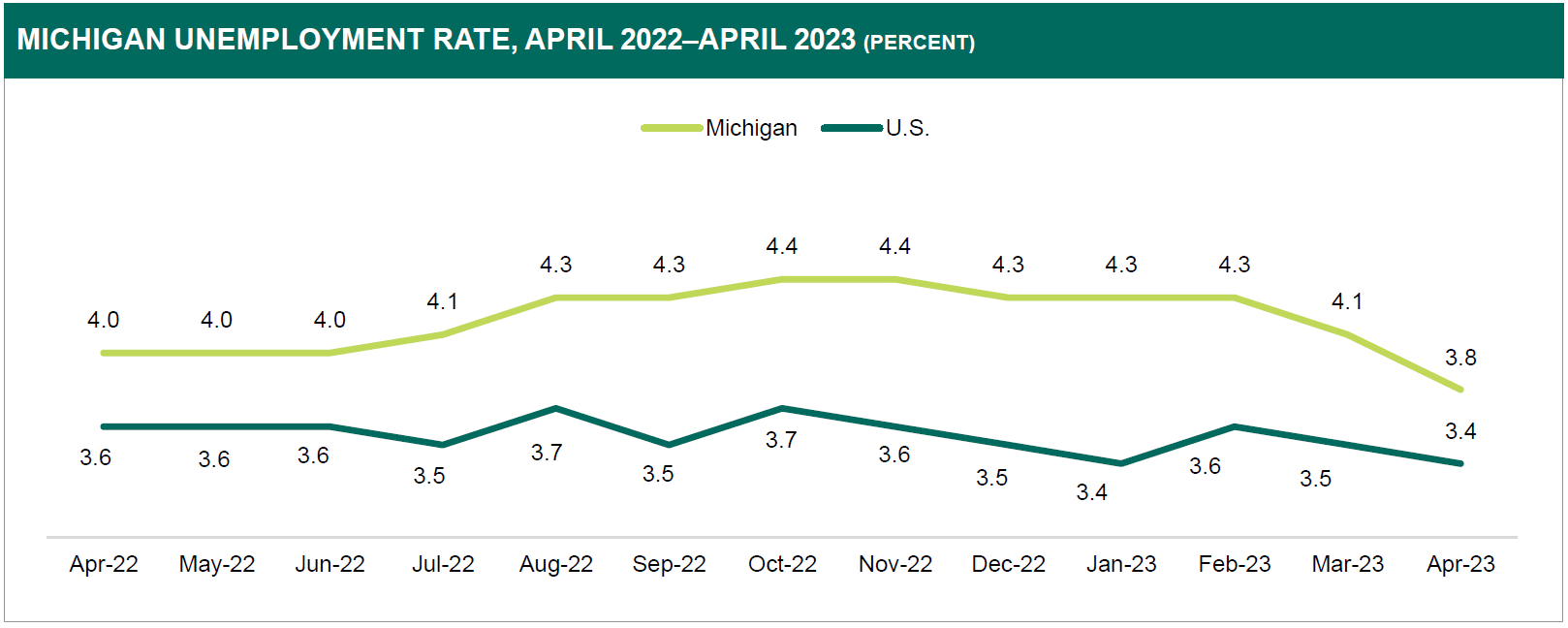
April Data - June Reporting
MICHIGAN UNEMPLOYMENT RATE DECLINES IN APRIL
Michigan’s unemployment rate saw a decline in April, dropping by three-tenths of a percentage point to reach 3.8 percent on a seasonally adjusted basis.
This marks the first time since the start of the pandemic that the state’s unemployment rate has returned to pre-pandemic levels, matching the rate of 3.8 percent recorded in February 2020. It is the lowest unemployment rate since March 2020 (3.7 percent), just before the pandemic significantly impacted Michigan’s labor market.
Despite pandemic-related employment disruptions, current unemployment rates are comparable to previous labor market trends. Historical labor market data reveals that since the mid-1970s, statewide unemployment rates fell below 4.0 percent during three periods: periodically from 1998 to 2000, from November 2019 to March 2020, and now.
The national unemployment rate decreased between March and April falling by one-tenth of a percentage point to 3.4 percent. Michigan’s jobless rate was 0.4 percentage points above the U.S. rate. Over the year, both national and statewide unemployment rates exhibited rate reductions of two-tenths of a percentage point.
In terms of the labor force, Michigan saw a 0.4 percent increase during April, while the U.S. labor force remained unchanged. Statewide employment levels rose by 0.6 percent over the month, slightly higher than the 0.1 percent increase seen nationwide. Total unemployment in Michigan fell by 7.0 percent over the month, while national unemployment declined by 3.1 percent.
Over the year, Michigan’s workforce grew by 0.5 percent, which was 1.2 percentage points below the national labor force increase of 1.7 percent. Statewide employment rose by 0.7 percent, slightly lower than the 1.9 percent increase observed nationally. Michigan’s total number of unemployed decreased by 3.6 percent since April 2022, while those unemployed nationally declined by 5.2 percent.
REIMA NASSER
Economic Analyst

Source: Local Area Unemployment Statistics, Michigan Center for Data and Analytics, Michigan Department of Technology, Management & Budget

Source: Local Area Unemployment Statistics, Michigan Center for Data and Analytics, Michigan Department of Technology, Management & Budget
MICHIGAN NONFARM PAYROLL EMPLOYMENT INCREASES DURING APRIL
Michigan nonfarm payroll jobs remained virtually flat during April, rising by only 5,200 (+0.1 percent) to 4,420,000, on a seasonally adjusted basis. This over-the-month uptick marks the sixth consecutive month of recorded job gains on the statewide level or the 21st time over the last two years. Nonfarm employment in Michigan remained only 0.7 percent (-29,500) lower than its February 2020 pre-pandemic job level.
On the nationwide level, total nonfarm payroll jobs increased by 0.2 percent over the month, only 0.1 percentage point above the statewide average for April. Nationally, this marked the 28th consecutive month of recorded job gains on a seasonally adjusted basis. The U.S. surpassed its pre-pandemic job level in mid-2022.
In April, seasonally adjusted job additions were recorded in many statewide major industry sectors and subsectors. Notable employment gains were recorded within Professional and business services (+2,600), Private educational and health services (+1,900), and Government (+1,400). On a percentage basis, the Construction (+0.6 percent) major industry sector recorded the largest over-the-month positive job change during April. Several Michigan major industry sectors recorded job declines in April as well, including Leisure and hospitality (-1,700), Information (-500), and Other services (-300).
Nationally, the Private education and health services (+0.3 percent), Professional and business services (+0.2 percent), and Government (+0.1 percent) major industry sectors also recorded monthly job additions during April. On the nationwide level, Wholesale trade, Retail trade, and Information remained flat over the month. The Administrative and support and waste (-0.1 percent) industry sector was the only sector to record a job decline in April.
Majority of Major Industry Sectors Record Yearly Job Additions
Over the year, nine of Michigan’s 11 major industry sectors recorded job gains since April 2022. Noteworthy additions were recorded in various major industry sectors including Construction (+4.3 percent), Government (+3.3 percent), and Private education and health services (+2.9 percent). The statewide Financial activities (-2.5 percent) and Other services (-1.7 percent) sectors both registered seasonally adjusted job declines during April.
Nationally, Private education and health services (+4.3 percent), Construction (+2.7 percent), and Government (+2.1 percent) also recorded job gains over the year. Additionally, every other major industry sector on the nationwide level also noted April job additions, on a seasonally adjusted basis.
Retail Trade Jobs Decline in Most Metro Areas in April
Over the month, 13 of Michigan’s 14 Metropolitan Statistical Areas (MSAs) recorded job growth, on a not seasonally adjusted basis. Led by the Bay City (+0.9 percent) region, four other metro areas recorded a job change greater than or equal to both the national and statewide average rates of change during April. The Niles-Benton Harbor area was the only region to record a negative rate of change (-0.3 percent), in April.
Jobs in the Mining, logging, and construction; Private educational and health services; and Leisure and hospitality industries remained either unchanged or increased in every metro area in Michigan during April.
Of the 13 Michigan metro areas that record Retail trade jobs, 11 recorded virtually no change or a job decline over the month, opposite their typical seasonal trend during April.
JIM BIRNEY
Economic Analyst

Source: Current Employment Statistics, Michigan Center for Data and Analytics, Michigan Department of Technology, Management & Budget

Source: Current Employment Statistics, Michigan Center for Data and Analytics, Michigan Department of Technology, Management & Budget

Source: Current Employment Statistics, Michigan Center for Data and Analytics, Michigan Department of Technology, Management & Budget
UNEMPLOYED TO JOB OPENINGS RATIO REACHES HIGHEST LEVEL IN ALMOST TWO YEARS
The job openings rate in Michigan declined by 0.3 percentage points from February to March (5.3 percent) according to the latest release of the Job Opening and Labor Turnover Survey (JOLTS). The separations rate (3.8 percent), the quits rate (2.9 percent), the labor turnover rate (7.5 percent), and the unemployed to job openings ratio (0.81) all increased over the month. The hires rate was stagnant at 3.7 percent for a second consecutive month.
Job Openings Down in March
In March, job openings in Michigan decreased by 15,000, dropping from 262,000 to 247,000. This decline resulted in the job openings rate falling to 5.3 percent, lower than the national rate of 5.8 percent and ranking Michigan 10th lowest among all states.
The unemployed to job openings ratio experienced a slight increase from 0.79 in February to 0.81 in March. This ratio reached its highest level since April 2021, indicating that there were still more job openings than unemployed individuals.
The Number of Hires Remain the Same in March
The number of hires in March remained stagnant at 3.7 percent, the same rate as the previous month. Michigan ranked 12th lowest among other states in this indicator, and was below the national rate of 4.0 percent.
Separations Experience a Slight Increase
Separations, which include both voluntary quits and involuntary layoffs or discharges, saw a slight increase in March. The separations rate rose by 0.7 percentage points to reach 3.8 percent. This increase translated to 32,000 more separations compared to the previous month. Michigan’s separation rate was equal to the national rate over the same period.
The rise in separations was driven by an increase in both voluntary quits and involuntary layoffs or discharges. The quits rate increased by 0.3 percentage points to 2.2 percent in March, while the layoffs and discharges rate jumped to 1.5 percent. Michigan’s quits rate ranked 11th lowest compared to other states, but was above the national rate for layoffs and discharges (1.2 percent).
Unemployed to Job Openings Ratio Hits a Near Two-Year High
The unemployed persons to job openings ratio is a metric that measures the current number of unemployed people relative to the availability of jobs. As mentioned earlier, this ratio recorded a high of 0.81, or eight unemployed persons per ten job openings. This was the highest this ratio has been since April 2021 (0.90). This can be attributed to both job openings and unemployment decreasing over the month, moving these two indicators closer to one another. The current recorded ratio makes the third consecutive month that this indicator has risen. With the ratio increasing for three consecutive months, it raises the possibility of a one-to-one relationship between job seekers and job openings in the future, meaning there would be an equal number of unemployed individuals and available jobs.
KRYSTAL JONES
Economic Analyst

Source: Job Openings and Labor Turnover Survey, U.S. Bureau of Labor Statistics

Source: Job Openings and Labor Turnover Survey, U.S. Bureau of Labor Statistics
Disclaimer
The Above Information was created and disseminated by the Department of Technology, Management, and Budget and the Bureau of Labor Market Information and Strategic Initiatives from the State of Michigan. Specialized Staffing does not hold any rights or ownership to this content. For more information, please contact your Michigan Bureau of Labor Representative.
